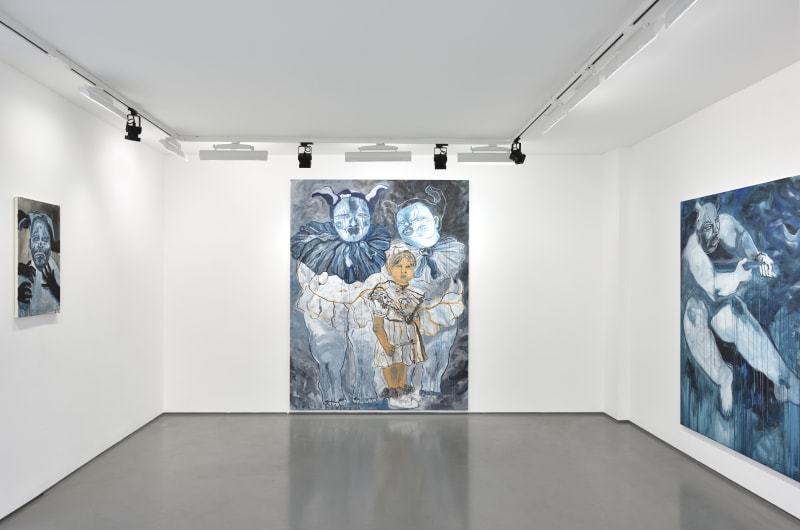The blue work: this is her first series of large-scale paintings, produced in the workshop at the Lens/Picault Collection artist residency where she is staying with her partner Tirdad Hashemi, and where the artists’ paintings communicate, side by side, sometimes losing themselves in each other. Soufia Erfanian has moved into blue—a blue-black the colour of ink—territory with her characters encircled in white and encumbered by patches of darkness. The blue work: I’d like it to recall the style of Marguerite Yourcenar (a writer originally from Brussels, a Northern
European neighbour), embodied in the title of her novel, she says, by borrowing a formula which “designates what is said to be the most difficult phase of the alchemist’s process, the separation and dissolution of substance”.(1) There you have it. The painting appears to be a way of invoking heavy and grotesque, thick and contorted characters and confronting their shared invention: lies. Hairless and chubby-cheeked, clown-like and gesticulating, in make-up and ruffs, these characters appear to share or fight over a much smaller creature, perhaps a child, removed from their everyday life to share their limitless blue-black world. Subject to the alchemical formula—the blue bleeding—these characters lose a little of their substance, their overwhelming presence, their awkward density and their duplicity. Soufia, who has taken a sabbatical from her career as a Mechanical Engineer (she studied Architecture at Azad University in Mashhad, Iran, and Mechanical Engineering at the Frankfurt University of Applied Sciences, Germany) to paint for a year, is frank. The series of Lies that bled blue pieces is a throwback to childhood, to the customary laws and legal violence which, in Iran, mark, break and deny the ties of parenthood, rewritten in the blue ink of lies. The colour evokes family situations lived in silence in a separate physical and perceptual space and keeps them in the shadows, in lies and farce, painted on the canvas; a condition that allows us to
remember, negotiate and, perhaps, transform.
Élisabeth Lebovici
(1) Marguerite Yourcenar, L’Œuvre au Noir (1968) Paris : Gallimard coll. « Folio »., p. 459.
Since meeting, Tirdad Hashemi and Soufia Erfanian have worked on both their personal projects and a joint series of pieces, co-signed by both artists. As an exercise, experience, extension or graphic parallel to their lives, these drawings depict their way of life and broader relationship with queer or banished communities where confidences are shared in the face of an external, geopolitical, economic and climatic reality, and an ever-present past, which form their hidden frame. Crafted like a conversation on the sheet, the drawings de-frame reality in a room of one’s own or, rather, a room of their own.
Élisabeth Lebovici

